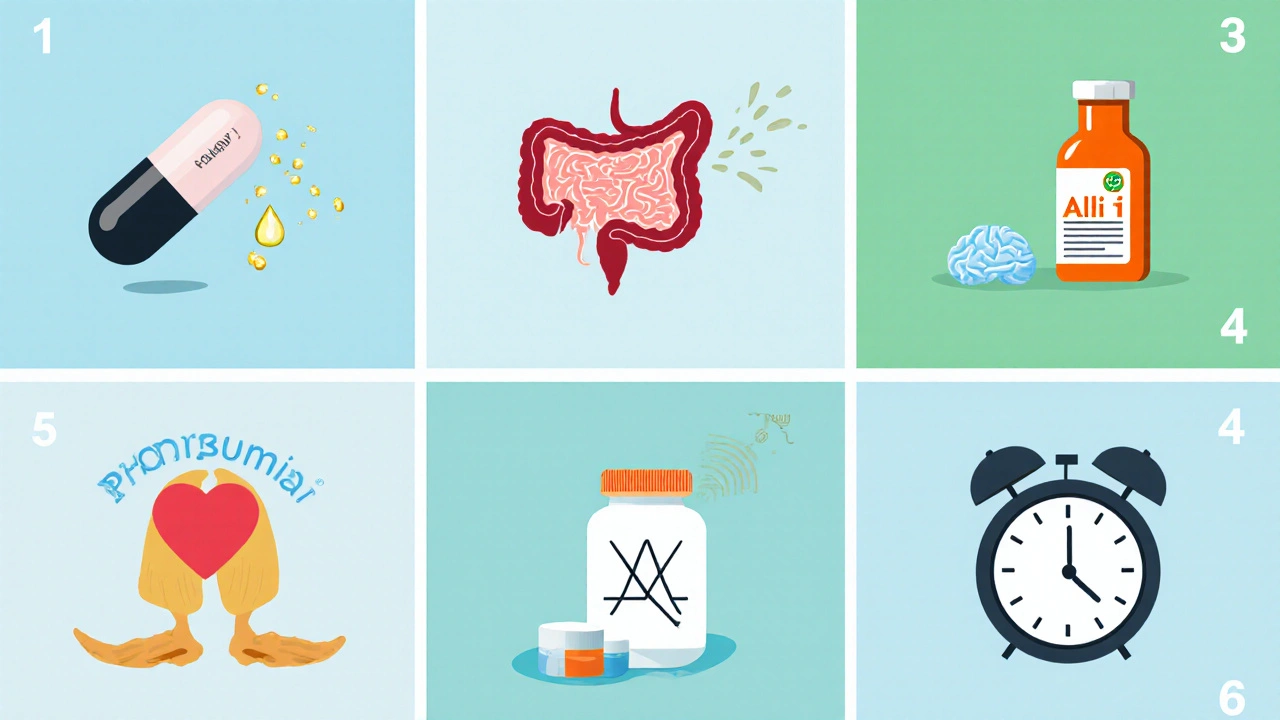Weight Loss Medication Selector
Your Weight Loss Goals
Your Preferences
Your Results
Select your criteria and click "Find Best Match" to see recommended options.
Trying to lose weight often feels like a maze of pills, diets, and conflicting advice. If you’ve heard about Orlijohn, the Australian brand of the lipase‑inhibitor Orlistat and wonder how it stacks up against other options, you’re not alone. This guide cuts through the hype, compares the most common weight‑loss medicines, and helps you decide which (if any) matches your health goals, budget, and lifestyle.
Key Takeaways
- Orlijohn blocks about 30% of dietary fat and works best with a low‑fat, high‑protein diet.
- Prescription‑only alternatives like Wegovy (semaglutide) can achieve 15‑20% weight loss but cost significantly more.
- Over‑the‑counter options such as Alli provide a milder effect (5‑10% loss) with fewer gastrointestinal side effects.
- Combination drugs (Contrave, Qsymia) target appetite and reward pathways but raise blood‑pressure concerns.
- Your choice should balance efficacy, safety, cost, and whether you need a prescription.
How Orlistat (Orlijohn) Works
Orlistat is a lipase inhibitor. It binds to the enzyme that breaks down dietary fat in the intestines, preventing about one‑third of the fat you eat from being absorbed. The undigested fat is then expelled in the stool. Because the drug acts only in the gut, it doesn’t affect the central nervous system, making it a non‑psychoactive option.
Typical dosing for Orlijohn is one 120mg capsule taken with each main meal that contains fat, up to three times a day. The drug must be taken with a meal containing at least 5g of fat; otherwise, it has no effect.
Top Alternatives to Orlistat
Below are the most frequently considered weight‑loss medicines in Australia as of 2025. Each has a distinct mechanism, efficacy range, and safety profile.
- Alli - low‑dose (60mg) Orlistat sold OTC.
- Wegovy - weekly injectable semaglutide (GLP‑1 agonist).
- Ozempic - another semaglutide formulation, originally for type2 diabetes.
- Contrave - combination of bupropion and naltrexone.
- Qsymia - phentermine plus topiramate.
- Phentermine - short‑term appetite suppressant.

Comparison Table: Efficacy, Cost, and Safety
| Medicine | Mechanism | Typical Weight‑Loss % (12mo) | Prescription? | Average AU$/month | Key Side Effects |
|---|---|---|---|---|---|
| Orlijohn | Lipase inhibition (blocks fat absorption) | 5‑10% (when paired with low‑fat diet) | Yes | ≈$45 | Oily stools, flatulence, abdominal cramps |
| Alli (OTC) | Low‑dose lipase inhibition | 3‑5% | No | ≈$30 | Similar GI effects, milder |
| Wegovy | GLP‑1 receptor agonist (appetite control) | 15‑20% | Yes | ≈$300 | Nausea, vomiting, constipation |
| Contrave | Bupropion+Naltrexone (reward pathway) | 5‑10% | Yes | ≈$120 | Headache, dizziness, increased BP |
| Qsymia | Phentermine+Topiramate (appetite + satiety) | 8‑12% | Yes | ≈$150 | Tingling, dry mouth, cognitive fog |
| Phentermine | Sympathomimetic (stimulates CNS) | 3‑5% (short‑term) | Yes (up to 12weeks) | ≈$50 | Insomnia, tachycardia, anxiety |
Decision Criteria: What Matters Most?
Before picking a pill, run through these checkpoints. Each one can tip the scales for or against Orlijohn.
- Desired weight‑loss magnitude. If you need modest change (5‑10% of body weight), Orlijohn or Alli often suffice. For larger goals, GLP‑1 drugs like Wegovy are proven to deliver up to 20% loss.
- Prescription willingness. Orlijohn requires a doctor’s script, while Alli is available off‑the‑shelf. Some users avoid the extra pharmacy visit.
- Budget. Monthly out‑of‑pocket cost varies dramatically-from <$30 for Alli to >$300 for Wegovy. Check whether your private health fund offers rebates.
- Side‑effect tolerance. Orlistat’s GI issues can be inconvenient, especially if you enjoy fatty foods. GLP‑1 agents often cause nausea but are generally “cleaner” on the gut.
- Medical comorbidities. Patients with uncontrolled hypertension should steer clear of Qsymia or Phentermine. Those with gallbladder disease may experience worsened symptoms on Orlistat.
Best‑Fit Scenarios
Match your profile with the drug that aligns best.
- Orlijohn is best for: Adults with BMI≥30 (or≥27 with risk factors) who can commit to a low‑fat diet and want a non‑central‑nervous‑system option.
- Alli works for: People hesitant about prescriptions and willing to tolerate milder weight loss.
- Wegovy shines for: Those needing substantial loss, have type2 diabetes or metabolic syndrome, and can afford higher costs.
- Contrave suits: Individuals who struggle with emotional eating, as bupropion helps mood regulation.
- Qsymia fits: Patients without cardiovascular issues who want a dual‑action pill and can handle occasional tingling sensations.
- Phentermine is for: Short‑term jump‑starts when rapid appetite suppression is needed, but not for long‑term maintenance.
How to Use Orlijohn Effectively
Even the best pill falls short without proper usage. Follow these practical steps to maximize results and minimize side effects.
- Take with meals that contain fat. Each capsule works only if the meal has at least 5g of fat. A teaspoon of olive oil or a handful of nuts meets the threshold.
- Stay hydrated. Drink at least 2L of water daily; this helps move undigested fat through the system.
- Consider a multivitamin. Orlistat can reduce absorption of fat‑soluble vitamins (A, D, E, K). A once‑daily chewable supplement taken at a different time mitigates deficiency risk.
- Monitor bowel changes. If oily stools become frequent, trim dietary fat further or speak to your GP.
- Combine with lifestyle coaching. Pairing the drug with a registered dietitian’s plan improves the odds of reaching the 5‑10% loss target.

Potential Pitfalls & How to Avoid Them
Every medication carries red flags. Knowing them ahead saves frustration.
- High‑fat diets. Eating pizza, fries, or butter‑rich meals defeats Orlistat’s purpose and amplifies greasy stools.
- Skipping meals. Taking a capsule on an empty stomach yields no effect but still risks GI upset.
- Drug interactions. Orlistat can lower the absorption of cyclosporine, levothyroxine, and certain HIV meds. Always flag your current prescriptions with your doctor.
- Pregnancy & breastfeeding. Not recommended; discuss alternatives if you’re planning a family.
- Long‑term reliance. The drug doesn’t teach sustainable habits. Use it as a bridge while building healthy eating patterns.
What the Research Says
Multiple randomized controlled trials (RCTs) across Australia and Europe have measured Orlistat’s impact. A 2023 meta‑analysis covering 8,000 participants reported an average 7.5% greater weight loss than placebo when paired with lifestyle counseling. By contrast, GLP‑1 trials consistently show 15‑20% superiority but at a cost premium of roughly 6‑7times higher.
Side‑effect profiles differ dramatically. The same 2023 analysis noted that 30% of Orlistat users experienced at least one GI event, while only 10% of Wegovy users reported nausea severe enough to stop treatment.
Bottom Line: Should You Choose Orlijohn?
If you’re comfortable with a prescription, can stick to a modest‑fat diet, and prefer a drug that won’t affect your heart rate or mood, Orlijohn remains a solid, evidence‑backed option. It won’t give you dramatic results overnight, but it can be the steady catalyst many people need when other approaches stall.
However, if you need a larger weight‑loss target, have the budget, and are okay with injections, GLP‑1 medicines like Wegovy are now the gold standard. For those who can’t or won’t take a prescription, Alli offers a low‑dose taste of Orlistat’s mechanism with fewer side effects.
Ultimately, discuss your health history with a GP or bariatric specialist, weigh the pros and cons listed above, and pick the route that aligns with your goals and lifestyle.
Frequently Asked Questions
How quickly does Orlijohn show results?
Most users notice a modest reduction in waist size within 4‑6weeks, provided they follow the low‑fat diet and take the medication with every meal containing fat.
Can I take Orlijohn if I have diabetes?
Yes, Orlistat is safe for most people with type2 diabetes, but it can affect the absorption of some oral diabetes meds (e.g., metformin). Your doctor may adjust dosages or recommend taking the vitamin supplement mentioned earlier.
Is Orlijohn suitable for teenagers?
Australian guidelines restrict Orlistat to adults (≥18years). For adolescents, lifestyle interventions and counseling are the first‑line approach.
How does the cost of Orlijohn compare to Wegovy?
Orlijohn averages about AU$45 per month, while Wegovy can exceed AU$300 per month. Insurance rebates for GLP‑1 drugs are limited, so the price gap is substantial.
Do I need to take a multivitamin with Orlistat?
Because Orlistat reduces absorption of fat‑soluble vitamins, a daily chewable multivitamin (A, D, E, K) taken at a different time from the pill is recommended by most clinicians.


Comments
Albert Gesierich
First off, the article is riddled with grammatical slip‑ups that undermine its credibility. For instance, it mixes “its” and “it’s” in the same paragraph, which is a basic error even a high‑school graduate should avoid. The phrase “You’ll notice a modest reduction in waist size within 4‑6weeks” lacks a space after the numeral, violating standard style guides. Moreover, the table header “Prescription?” is missing a closing tag in the source, signalling careless copy‑pasting. If you want readers to trust the data, clean up these mistakes before you start peddling pills.
October 13, 2025 at 21:42
Suraj Midya
i cant stand people who pop pills without thinking about the impact on their families and the planet, especially when cheap alternatives exist.
October 23, 2025 at 23:24
ashish ghone
Hey buddy, I get how overwhelming the whole weight‑loss med maze can feel 🙏. Remember that any drug, even Orlijohn, works best when you pair it with a balanced diet and consistent movement. If you’re worried about the oily stools, start with a modest fat intake – a drizzle of olive oil or a handful of nuts is enough to activate the capsule. Keep a journal of what you eat and how you feel; patterns will emerge faster than you think. And don’t forget to grab a daily multivitamin at a different time to offset the fat‑soluble vitamin loss – that’s a game‑changer! 🌟
November 3, 2025 at 01:07
steph carr
It’s great that you’re exploring options and not just settling for the status quo – that curiosity can be the spark that leads to lasting change.
November 13, 2025 at 02:50
Vera Barnwell
There’s a hidden agenda behind the glowing endorsements of GLP‑1 drugs that most mainstream articles conveniently ignore. Big pharma has been funneling billions into marketing campaigns that portray semaglutide as a miracle cure, all while quietly lobbying against stricter regulations. If you look at the patent filings, you’ll see a pattern of ever‑shrinking dosing intervals designed to keep patients locked into an endless subscription. The same board that pushes Wegovy also funds think‑tanks that downplay the gastrointestinal side effects of Orlistat, painting them as harmless. Meanwhile, independent researchers who have raised concerns about long‑term nutrient deficiencies are dismissed as “anecdotal” in the press. The article mentions multivitamins as a solution, but does not warn that many over‑the‑counter formulas are themselves funded by the same corporations. Even the dietary recommendations often slip in subtle advertisements for “low‑fat” products that are loaded with hidden sugars. Notice how the cost comparison focuses on monthly price, never addressing the hidden insurance copays that can double the out‑of‑pocket expense. In several countries, the government health agencies have issued warnings about the off‑label use of these injectables, yet the article glosses over that entirely. What’s more, there’s a growing body of evidence that long‑term use of GLP‑1 agonists may affect pancreatic health, a fact that is buried deep in specialist journals. The narrative that Orlistat is “non‑psychoactive” is technically true, but it conveniently ignores the psychological burden of dealing with oily stools in public. If you combine that with the fact that many patients report severe vitamin deficiencies, the risk‑benefit balance becomes far less clear. One should also question why the article never mentions the role of lifestyle coaching, which is the most cost‑effective intervention with lasting results. All of this points to a coordinated effort to keep the consumer focused on pills rather than sustainable habits. So before you sign a prescription, dig into the original studies, ask about conflicts of interest, and consider whether you’re being sold a shortcut or a trap.
November 23, 2025 at 04:33
Barbra Wittman
Oh sure, just pop a pill and magically watch the pounds melt away while ignoring the fact that you still have to eat vegetables – because that’s never happened before, right?
December 3, 2025 at 06:16
Lynnett Winget
Picture this: a kale‑green smoothie swirling like a sunrise, a capsule of Orlijohn joining the party, and you, the daring alchemist, turning stubborn fat into biodegradable confetti. It’s a culinary adventure where science meets art, and every bite feels like a brushstroke on the canvas of your waistline.
December 13, 2025 at 07:59
Write a comment